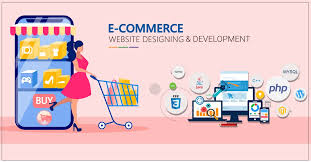In today’s competitive digital landscape, integrating effective landing page design with robust e-commerce website development is crucial for Australian businesses aiming to capture and convert potential customers. The seamless integration of these two elements can significantly impact user experience, engagement, and conversion rates, thereby driving business growth. This article explores key insights on how Australian businesses can effectively integrate landing page design with e-commerce website development.
The Importance of Landing Page Design
A landing page is often the first point of interaction between a potential customer and a business. Its primary purpose is to capture leads or drive sales by persuading visitors to take a specific action. According to a study by HubSpot, companies with 10 to 15 landing pages increase leads by 55%, highlighting the importance of having well-designed landing pages.
Key Elements of Effective Landing Page Design:
- Clear Call-to-Action (CTA): A strong, clear CTA guides visitors on what action to take next, such as making a purchase or signing up for a newsletter.
- Compelling Headlines: Headlines should be attention-grabbing and convey the value proposition effectively.
- Visual Appeal: High-quality images and a clean layout enhance the visual appeal, making the page more engaging.
- Minimal Distractions: Removing unnecessary elements ensures that visitors focus on the desired action.
The Role of E-commerce Website Development
E-commerce website development involves creating a platform that facilitates online transactions, product listings, customer accounts, and payment processing. An effective e-commerce website should be user-friendly, secure, and scalable to accommodate business growth.
Key Features of Successful E-commerce Websites:
- User-Friendly Navigation: Easy-to-use navigation helps visitors find products quickly, enhancing their shopping experience.
- Mobile Optimization: With mobile commerce on the rise, having a mobile-optimized website is essential. According to Statista, mobile commerce accounted for 72.9% of total e-commerce sales in 2021.
- Secure Payment Processing: Ensuring secure transactions builds customer trust and protects sensitive information.
- Fast Load Times: According to Google, 53% of mobile site visitors leave a page that takes longer than three seconds to load.
Integrating Landing Page Design with E-commerce Website Development
Integrating landing page design with e-commerce website development in Australia requires a strategic approach to ensure that both elements complement each other, enhancing overall user experience and conversion rates.
- Consistency in Design: Maintaining consistency in design elements, such as color schemes, fonts, and imagery, across landing pages and the e-commerce site creates a cohesive brand experience. This consistency builds trust and reinforces brand identity.
- Seamless User Experience: Ensuring a seamless transition from the landing page to the e-commerce site is crucial. For instance, if a landing page promotes a specific product, clicking on the CTA should take the visitor directly to that product’s page on the e-commerce site. This seamless experience reduces friction and increases the likelihood of conversion.
- Personalized Content: Using personalized content on landing pages can significantly enhance user engagement. For example, if a visitor arrives at a landing page through a specific marketing campaign, the content should be tailored to reflect the campaign’s messaging. Personalized content can increase conversion rates by up to 202%, according to a report by Econsultancy.
- A/B Testing: Conducting A/B tests on landing pages helps identify which design elements, headlines, and CTAs perform best. Insights gained from these tests can be applied to optimize both landing pages and the e-commerce site, ultimately driving higher conversions.
- Analytics and Tracking: Implementing analytics tools, such as Google Analytics, allows businesses to track user behavior on landing pages and the e-commerce site. Analyzing this data provides valuable insights into what works and what doesn’t, enabling continuous improvement.
Case Study: Australian Businesses Leading the Way
Several Australian businesses have successfully integrated landing page design with e-commerce website development, setting an example for others to follow.
Example 1: The Iconic The Iconic, a leading online fashion retailer in Australia, effectively integrates landing pages with its e-commerce site. Each landing page is designed to reflect the brand’s aesthetic and guides visitors seamlessly to the relevant product pages. Their use of high-quality images, clear CTAs, and personalized content has contributed to their success in the competitive online retail market.
Example 2: Kogan Kogan, an Australian-based online retailer, uses landing pages to promote specific products and sales events. Their landing pages are visually appealing and feature concise, persuasive content. By maintaining design consistency and ensuring a smooth user experience, Kogan has achieved high conversion rates and customer satisfaction.
Choosing the Right Partner
For businesses looking to integrate landing page design with e-commerce website development, selecting the right partner is crucial. A specialized landing page design company in Australia can provide the expertise needed to create high-converting landing pages. Similarly, partnering with a reputable e-commerce website development company ensures the technical aspects of the website are handled professionally.
Factors to Consider When Choosing a Partner:
- Experience and Portfolio: Review the company’s portfolio and past projects to assess their expertise and experience.
- Client Testimonials: Reading client testimonials and reviews provides insights into the company’s reliability and quality of service.
- Customization and Scalability: Ensure the company can offer customized solutions tailored to your business needs and can scale as your business grows.
- Support and Maintenance: Opt for a partner that provides ongoing support and maintenance to address any issues promptly and keep the website running smoothly.
Conclusion
Integrating landing page design with e-commerce website development is essential for Australian businesses aiming to maximize their online presence and drive conversions. By focusing on design consistency, seamless user experience, personalized content, and data-driven optimization, businesses can create an engaging and effective online shopping experience. Partnering with a specialized landing page design company in Australia and a reputable e-commerce website development firm ensures the best results, ultimately contributing to business growth and success in the competitive e-commerce landscape.



